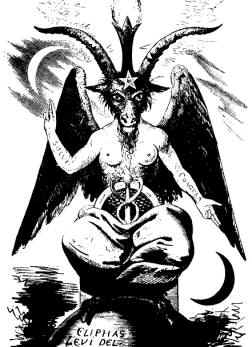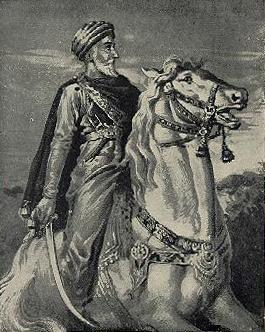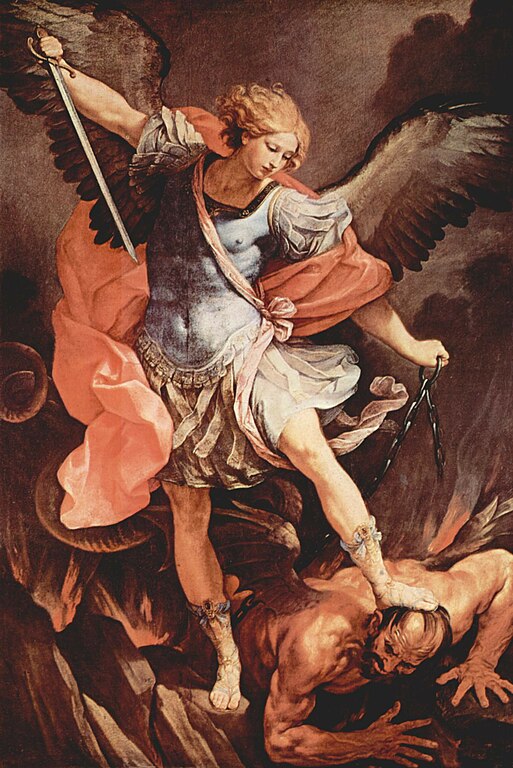 |
| Classical Satan he-goat with Hermetic symbols |
Oh Satan, you that to consolate the poor in their suffering teach us to mix saltpeter, coal and sulfur...
That's how a maudit poet of the 19th century, Baudelaire, decided that the most famous supervillain of the last two millennia could be vindicated: as a rebel. This was a very common stand in the Romantic period but for centuries before that any such idea could have brought you to a slow and most painful death.
Because it was for the Christian churches to invent the most perfected supervillain ever: Satan, aka Lucifer, aka the Devil... We can well say that there were no true supervillains before him and that all that came later are just imitations. Not in vain the word propaganda is a Catholic creation.
The Bible has only vague and sparse mentions to the Devil. It is not ever clear what they are talking about, maybe Pagan gods that competed with Yaveh or maybe vague ideas of dissidence incarnated in imaginary beings. In any case there is nothing clear in the Bible about the Devil, yet it features prominently in the modern Christian and Muslim imaginary, incorporating all that is opposed to the teachings of such religions, either as mere common deviation (sin) or as ideological opposition (heressy).
In the Western imaginary, Satan has acquired horns and animal features, often as black billy goat. But what is the black billy goat?
 |
| Akerbeltz, modern rendering |
Among the ancient Aquitanian writings in funerary and votive slabs, there is one, quite famous, that is dedicated to the Black He Goat God: Aherbelts Deo. Akerbeltz (aker beltz) meaning in Basque black (beltz) he-goat (aker). There is no possible mistake here.
In Basque mythology Akerbelts appears often as symbol of Goddess Mari, not as a distinct god on its own right, and were used to ward off evil from farmsteads and homes (I have seen them chained before farmhouses on occasion, they can certainly ward you off with their horns).
It is very possible that this veneration of the Black He-Goat, more or less credibly documented to have being prominent in akelarreak (sabbaths) in the 16th century, when the Inquisition was also quite prominent, has some other roots, but whether it goes to the Dyonisian ritual orgies or to the even older carnival celebrations often featuring a horned beast, I can't say for sure.
 |
| Akelarre by Goya |
What is clear is that in the time of the Roman domain, there was already a clear consciousness of this religious character of the Black He-Goat, as documented by the Aquitanian slab.
Whatever the case the Christian Devil is such a distilled evil that all that was ever imagined as atrocious falls upon him. Fighting the mightiest of all superheroes ever, the sole and only God, mind you, all powerful and all encompassing, the Devil has absolutely not a chance... yet he insists once and again.
There's obviously something very wrong about him... or maybe about God, after all why would anyone rebel against such superpower unless there is something that really doesn't work, that demands rebellion even against all odds? That's how the Devil became superhero and God was dethroned after all...
 |
| Da Beast, per somebody's bad trip |
But still, in the minds of those who believe in all that Manichean composition, fed by the hallucinogenic baroque fantasy known as the Apocalypse or Revelation, Satan, aka the Beast, occupies a unique place among all supervillains. So unique that we still have to read Superman against Satan... or anything like that. Supervillains like the Joker maybe vaguely Satanic but they are not the real thing of course, just imitators.
Per the Apocalypse/Revelation, this supervillain is bound to arrive to Earth... but he's late at least a thousand years, so...
It'd be cool, admittedly if a supervillain would be acting that way out of rebellion: making God wait a thousand years or more for what has been announced as the final battle between good and evil sounds cool, admittedly. Can you win if the enemy does not come? Oops, sorry, the Enemy, capitalized. How good is a technical victory in such a major moral conflict? Can you be defeated by boredom while you wait?
I think so.
Oddly enough the nemesis of Satan is not God, who seldom bothers with such petty things, it seems. For that he uses his lead superhero Michael (below).
...
A little effeminate for modern standards maybe but he's an angel, and angels have all the sex... or are hermaphrodites... or something (there was something odd about the sex of angels but can't recall what was it).
By comparison, Satan seems to be a fully bearded man, even if also angelic (winged).
Asssassins
 |
| Modern rendering of Hassan i Sabbah |
Besides mythology, there are some other supervillains from the Middle Ages I can recall. Maybe the best known of all them are the Assassins.
The Assassins is the popular misnomer for one of the largest Shia sects: the Nizaris, now led by the Aga Khan. Because of their secrecy, their flirting with heresy (once they even proclaimed the Resurrection on Earth and hence drank wine with their backs to Mecca) and their tactics of political blackmail, this small sect became the one of the most famous supervillains of all times, specially their most charismatic leaders: Hassan i Sabbah, the mysterious founder and imam, and Sinan ed-Din, who lead the Syrian (Lebanese) branch of the sect in the time of the IV crusade, impacting both sides almost equally.
Legend says that Sinan sent an emissary to Saladin. This one asked him to dismiss everyone as what he had to tell him was only for his ears. He did so except for two bodyguards. When the emissary asked him to dismiss them as well, Saladin protested that he trusted them like his own children. So Sinan's messenger then asked the bodyguards: if I command in the name of my master to kill Saladin would you do it? Unsheathing their swords they replied: at the moment. Since then on Saladin did not bother the Assassins.
The Assassins had certainly inspired many modern supervillains both fictional and "real". However they lack of a corresponding superhero, so they are anomalous among supervillains.
They were eventually defeated indeed but by the brute force of another supervillain: Möngke Khan, whose destruction of Baghdad was so throughout that changed Islam forever, from a rather open culture into a closed one reluctant of all things foreign.
Hungarians
I should also mention the Magyars or Hungarians, whose raids for young women, killing everybody else, too young or too old, made them the most infamous barbarians of the Middle Ages for a whole century (by comparison the Vikings were almost friendly while the Arabs were the cusp of civilization, even if hostile). Then they suddenly converted to Christianity and declared their loyalty to the German Emperor and the Pope.

No comments:
Post a Comment
Please, be reasonably respectful when making comments. I do not tolerate in particular sexism, racism nor homophobia. The author reserves the right to delete any abusive comment.
Comment moderation before publishing is... ON